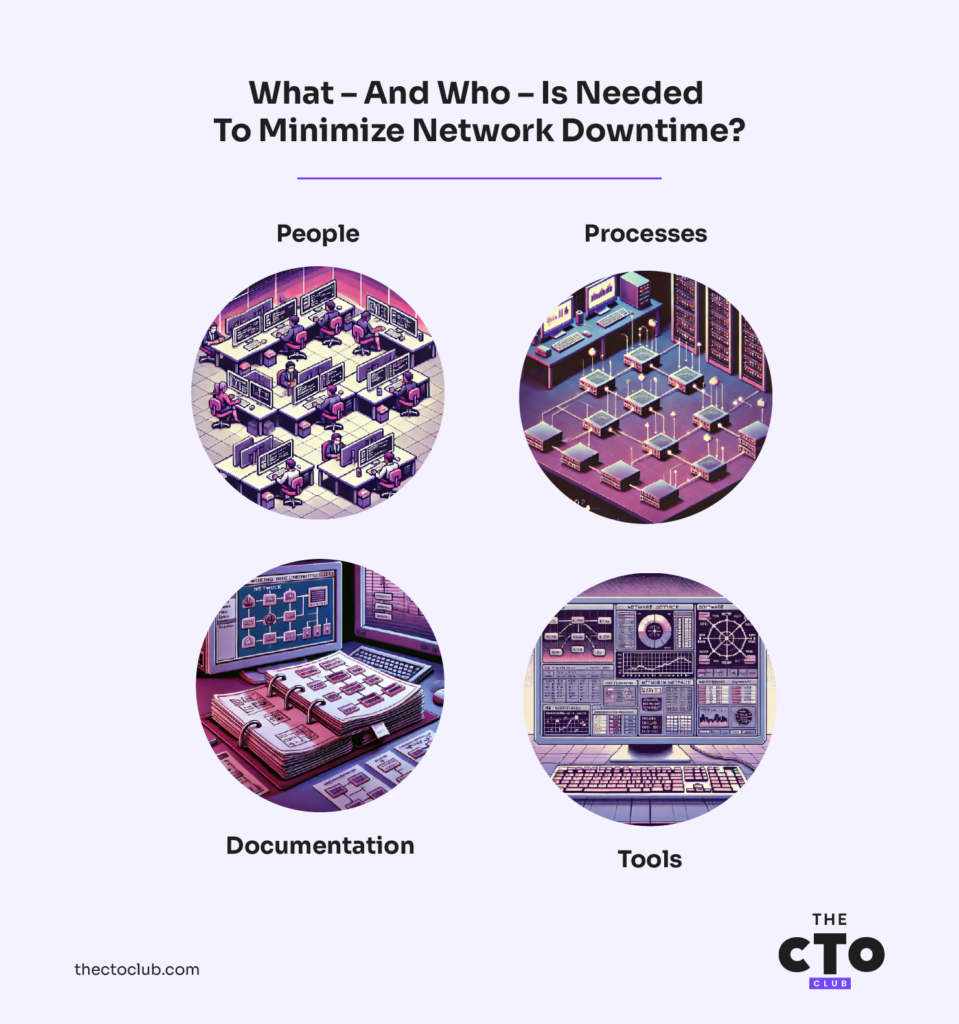Non-techies might hear “downtime” and think wistfully about a vacation. But for technology professionals, downtime is a dirty word – and rightfully so. Network downtime means a bad day at the office.
Network downtime means unhappy customers, plummeting productivity, and other problems. When you’re talking about customer-facing apps like a website, downtime is expensive: downtime costs larger companies approximately $9,000 per minute.
And while downtime can negatively impact businesses of all types and sizes, it’s especially problematic in certain industries. A retail business could lose $1.1 million per hour of downtime.
TL;DR: Downtime is bad.
Reducing and preventing downtime, on the other hand, is good. In fact, it’s a must – because even small amounts of network downtime can hurt the bottom line and cause collateral damage such as reputation harm.
In this article, we’ll define the problem and what’s required to solve it – including a 13-step framework for developing your own plan to reduce network downtime. First, it helps to ground ourselves in a simple definition.
What is Network Downtime?
Network downtime refers to part or the entirety of an IT network becoming unavailable, rendering things like a website or internal applications such as an ERP system inaccessible for some period of time.
Downtime can generally be grouped into two big categories: planned and unplanned. Planned downtime is just that: It’s intentional and scheduled, usually for things like routine maintenance, system upgrades, or an application migration.
When we say network downtime is bad, we really mean unplanned network downtime – this is when the network goes down unexpectedly for any number of potential reasons. There can be all sorts of causes for downtime, from infrastructure problems to software bugs to human error to cyberattacks.
What – And Who – Is Needed To Minimize Network Downtime?
Given the quantitative and qualitative costs, even infrequent network downtime is worth taking steps to address. And if the needle starts moving from infrequent toward frequent, then it’s time to solve that problem with greater urgency.

There is a mix of people, processes, documentation, and tools you should organize first, says Viacheslav Petrenko, Chief Technology Officer at the software development company LITSLINK.
Petrenko shared his advice on the key pieces you should get in order before embarking on a new initiative to reduce network downtime. These can be both forward-looking and historical. They include:
Documentation
Petrenko advises collecting network topology diagrams, incident reports, service level agreements (SLAs), and change management logs as fundamental documentation.
Any other relevant organization- or network-specific documentation is worth keeping handy as well.
Processes
There are several processes experts recommend analyzing – or implementing, if they’re currently not in place – as part of a network uptime initiative. These include:
Root Cause Analysis (RCA) protocol: This is a fundamental process for reducing network downtime, because it’s ultimate purpose is to identify the specific cause(s) of the problem. Root cause analysis “ensures thorough investigation of each downtime incident to prevent recurrence,” Petrenko says.
Related read: 5 Root Cause Analysis Tools For Better Testing & QA
Change management process: Minimizes risk by carefully controlling and documenting all network changes. Caution: Must balance thoroughness with agility to avoid bottlenecks.
Disaster recovery and business continuity plans: Any efforts to reduce network downtime should be informed by – and vice versa – the organization’s broader plans for resiliency in the face of major operational disruptions.
Related read: Decoding The 25 Best Disaster Recovery Services
Network maintenance schedule: Doing proactive maintenance – which may sometimes invoice planned downtime – “helps prevent issues before they occur by regularly updating and optimizing network components,” Petrenko says.
People
Virtually everyone in an organization relies on its network, but that doesn’t mean they all need to be involved in optimizing its performance and reliability. Petrenko lists the following roles as important to include in the process. Keep in mind that specific job titles can vary from company to company.
Network engineers: Needless to say, the professionals who implement and maintain your network infrastructure need to be a part of the process.
Systems administrators: Likewise, the people who manage the servers (and other infrastructure) and applications that rely on the network should be involved. Related titles here could include DevOps engineer, Site Reliability Engineer, and Infrastructure Engineer.
Security pros: Involving your security personnel helps “ensure network security and protect against downtime caused by attacks or breaches,” Petrenko says.
Data analysts: As evident in the documentation listed above, optimizing a network entails analyzing large amounts of performance data and other information. You need people with the skills to interpret that data and generate insights for improvement.
Project manager: In large enterprises especially, you may need someone to coordinate efforts across teams and keep things on schedule.
Tools
We’ll cover tools for reducing network downtime in more depth below, but suffice it to say for now that you’ll need some, with a particular focus on (but not limited to) monitoring, logging, testing, and planning. Specific categories here include:
Network monitoring software: You can’t solve problems if you don’t even know they exist. These tools ensure real-time visibility into your network and its performance and can generate alerts on possible issues.
Configuration management tools: Configuration management tools can automate and track changes to network infrastructure and devices, which Petrenko points out can reduce the risk of human error when changes are made.
Log management software and log analysis tools: Logging is a crucial means of establishing baseline patterns and “normal” behavior on a network – and then identifying abnormal activity before it potentially causes an outage.
Automated testing tools: Automating testing and QA efforts helps catch issues faster and also reduces the amount of human effort required.
Capacity planning software: Capacity planning – often a feature of networking monitoring tools – can help predict future network requirements and prevent downtime due to overload. Petrenko notes that this requires accurate data input and regular updates to remain effective.
-

Auvik
Visit WebsiteThis is an aggregated rating for this tool including ratings from Crozdesk users and ratings from other sites.4.7 -

Atera
Visit WebsiteThis is an aggregated rating for this tool including ratings from Crozdesk users and ratings from other sites.4.6 -

ManageEngine OpManager
Visit WebsiteThis is an aggregated rating for this tool including ratings from Crozdesk users and ratings from other sites.4.3
Reduce Network Downtime in 13 Steps
So what do you actually do with all of the above? We’ve got you covered: Petrenko shared with us a 13-step action plan that you can use to develop your own strategy based on your organization and its network’s specific characteristics and goals.
Let’s get to it:
- Assess Current State: This is where you collect, organize, and analyze all of the components we discussed above, including documentation and other relevant data.
Petrenko’s advice: “Consider bringing in external consultants for an unbiased view, but ensure all internal stakeholders are involved to get a comprehensive picture.”
- Define Your Goals: “Reduce downtime” is a fine overarching goal, but break that down into more specific targets for your network performance.
Petrenko’s advice: “These goals should be ambitious yet realistic, taking into account industry standards and specific business needs.”
- Assemble Your Team: Create a cross-functional team with the necessary skills, knowledge, and decision-making authority needed to achieve results.
Petrenko’s advice: “Avoid creating silos and establish good communication channels between all team members.
- Implement Monitoring Tools: Comprehensive network monitoring and analysis software is critical for any network uptime initiative.
Petrenko’s advice: “You'll need to decide between on-premises, cloud-based, or hybrid solutions based on your infrastructure.”
- Establish Your Key Metrics & Baselines: You can’t progress toward a goal if you don’t know where you started.
Petrenko’s advice: “Measure current performance to set a starting point for improvements. It's crucial that these metrics are consistent and relevant to your defined objectives.”
- Identify & Prioritize Critical Issues: Depending on the current state of your network, it’s unlikely that you can solve all underlying issues at once. So, prioritize the most significant causes of downtime. “Significance” can be understood holistically based on your organization’s goals, as Petrenko notes below.
Petrenko’s advice: ”When prioritizing, consider both the frequency and impact of issues.”
- Expand Your Strategy: Develop a detailed plan to address all identified issues (once the high-priority issues are tackled), including timelines and resource allocation.
Petrenko’s advice: ”Remember not to try fixing everything at once; prioritize based on impact and feasibility.”
- Develop Redundancy and Failover Systems: Redundancy in critical network components and automated failover processes are both key components of a long-term strategy for network performance and resiliency.
Petrenko’s advice: “This could include redundant hardware, multi-path network designs, or cloud-based failover systems. Be careful that your redundancy doesn't introduce unnecessary complexity that could itself become a source of issues.”
- Implement Changes: It’s execution time, starting with high-priority items.
Petrenko’s advice: “Make sure to follow change management processes to minimize the risk of introducing new issues.”
- Monitor and Adjust: No plan ever goes to perfection, so be prepared to adapt as you work through your strategy.
Petrenko’s advice: “Continuously track performance metrics and adjust the plan as needed. You might want to implement automated alerts for quick response to emerging issues.”
- Conduct Regular Professional Development: Any large-scale initiative to reduce downtime is inevitably going to entail people learning new technologies and processes. Don’t expect staff to just figure it out as they go.
Petrenko’s advice: “Implement ongoing training programs for staff to stay updated on best practices and new technologies. This should include both technical and procedural training to ensure all team members are equipped to prevent and respond to downtime issues.”
- Run Disaster Recovery Drills: Like most types of emergency planning, you obviously hope to never actually need it. But if you do, you’ll want to ensure you’ve tested your plans through simulated outages and other issues.
Petrenko’s advice: “Try to make these drills as realistic as possible without risking actual downtime.”
- Track and Report Your Progress: Regularly evaluate your progress toward the objectives (Step 2) and improvements to your baseline metrics, and share the results with stakeholders.
Petrenko’s advice: “In your reporting, use both technical metrics and measures of business impact to give a complete picture.”
Tools For Reducing Network Downtime
What software and other tooling can play a vital role in minimizing downtime and improving overall network health and performance? We’ve included examples in each category.
1. Network Monitoring Tools
- SolarWinds Network Performa nce Monitor (NPM): Provides comprehensive network performance monitoring, fault detection, and alerting.
- Nagios: Offers robust network monitoring, alerting, and reporting features.
- PRTG Network Monitor: A versatile tool that monitors all aspects of your network infrastructure.
2. Network Management and Configuration Tools
- Cisco Prime Infrastructure: Helps manage and optimize your network infrastructure.
- WhatsUp Gold: Provides network monitoring and management, including configuration management.
3. Automated Incident Response Tools
- PagerDuty: Integrates with monitoring tools to provide incident response and automated alerting.
- Opsgenie: Offers on-call management, incident response, and alerting.
4. Fault Management Tools
- Zabbix: Monitors network performance and helps detect and resolve faults.
- ManageEngine OpManager: Provides fault management, performance monitoring, and network visualization.
5. Network Configuration Backup and Restore Tools
- RANCID (Really Awesome New Cisco confIg Differ): Automates network device configuration backup and management.
- SolarWinds Network Configuration Manager (NCM): Automates configuration backup and recovery, and helps ensure compliance.
6. Log Management and Analysis Tools
- Splunk: Collects and analyzes logs from network devices to identify and troubleshoot issues.
- ELK Stack (Elasticsearch, Logstash, Kibana): Provides powerful log management and analysis capabilities.
7. Traffic Analysis Tools
- Wireshark: A network protocol analyzer that helps diagnose network issues.
- NetFlow Analyzer: Monitors network traffic patterns and helps identify bottlenecks.
8. High Availability and Failover Solutions
- F5 BIG-IP: Provides load balancing, failover, and high availability for network services.
- Cisco ASA: Offers robust firewall and failover capabilities.
9. Performance Testing Tools
- iPerf: Measures network bandwidth and performance.
- SolarWinds WAN Killer: Simulates network traffic to test network performance under different conditions.
10. Virtual Private Network (VPN) Tools
- OpenVPN: Provides secure remote access to the network, ensuring connectivity during downtime.
- Cisco AnyConnect: A secure VPN solution that provides remote access to network resources.
11. Endpoint Monitoring Tools
- Sysdig: Monitors and secures containerized environments and cloud infrastructure.
- Datadog: Provides full-stack monitoring, including network, server, and application monitoring.
12. Cloud-Based Network Monitoring Tools
- ThousandEyes: Provides end-to-end visibility into network performance across the internet and cloud.
- LogicMonitor: A cloud-based monitoring tool that offers comprehensive network monitoring capabilities.
The Bottom Line
Network downtime is a reality for most organizations, but that doesn’t mean you should let it go unchecked. Use the game plan and tools above to boost your network’s performance and minimize costly downtime.
For more network insights, please subscribe to our newsletter. We're helping you build SaaS teams and systems that scale!







